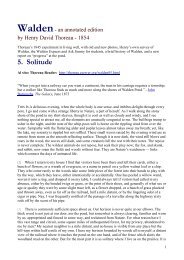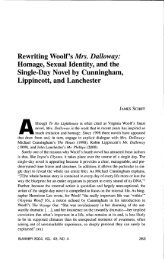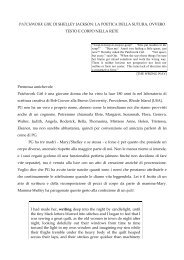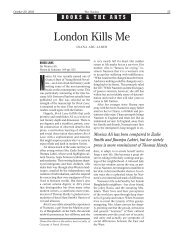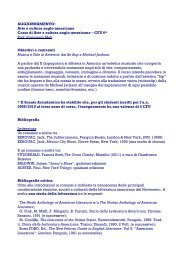Exciting Tales of Exotic Dark India - Paola Carbone
Exciting Tales of Exotic Dark India - Paola Carbone
Exciting Tales of Exotic Dark India - Paola Carbone
You also want an ePaper? Increase the reach of your titles
YUMPU automatically turns print PDFs into web optimized ePapers that Google loves.
<strong>Exciting</strong> <strong>Tales</strong> <strong>of</strong> <strong>Exotic</strong> <strong>Dark</strong> <strong>India</strong> 285<br />
some critics perceive as a re-Orientalist construction <strong>of</strong> <strong>India</strong> in The White<br />
Tiger, this article situates the debates about the perceived authenticity/<br />
inauthenticity <strong>of</strong> Adiga’s portrait within the broader problematic <strong>of</strong><br />
so-called “real” <strong>India</strong>nnness. As argued in countless studies, the quest<br />
for authenticity in IWE is inescapably doomed to failure, because that<br />
would imply the existence <strong>of</strong> a tangible origin (undermined from the<br />
outset by the use <strong>of</strong> a non-autochthonous language introduced via British<br />
colonization) against which to gauge it. In this respect Aamir Mufti, in<br />
his discussion <strong>of</strong> “auratic criticism”, identifies<br />
a pervasive language and mood in the contemporary critical scene that is<br />
concerned with the inauthenticity <strong>of</strong> postcolonial culture, community, and<br />
politics, and in which authenticity comes to attach itself to the concepts <strong>of</strong><br />
certain cultural practices as a kind <strong>of</strong> aura, as the practices themselves come<br />
to be seen as resources for the overcoming <strong>of</strong> the forms <strong>of</strong> alienation that<br />
are the result, and the subjective dimension, <strong>of</strong> the colonial encounter. 44<br />
Although the concept <strong>of</strong> authenticity has been discredited by many in<br />
contemporary critical discourse, it continues to play a prominent role in<br />
the debates about IWE and remains a crucial element in enhancing the<br />
appeal <strong>of</strong> non-western cultural products in a global market. Because it<br />
continues to provide a fertile ground for discussion <strong>of</strong> IWE, the explanatory<br />
potential <strong>of</strong> the concept <strong>of</strong> authenticity should not be dismissed. Indeed,<br />
the “anxiety <strong>of</strong> <strong>India</strong>nness” – or rather “anxiety about the anxiety <strong>of</strong><br />
<strong>India</strong>nness”, as the novelist Vikram Chandra characterizes it in a direct<br />
reference to the title <strong>of</strong> an influential essay by the critic Meenakshi<br />
Mukherjee 45 – ultimately structures the reception <strong>of</strong> the novel and most<br />
<strong>of</strong> the most fiery responses to it.<br />
For the remainder <strong>of</strong> this section, I will briefly outline the workings<br />
<strong>of</strong> the rhetoric <strong>of</strong> “real” <strong>India</strong>nness as Chandra describes it and as it is<br />
used repeatedly by reviewers, and then advance a reframing <strong>of</strong> this issue<br />
in relation to The White Tiger. Such change <strong>of</strong> perspective will hopefully<br />
allow for a reading <strong>of</strong> Adiga’s novel unconstrained by the unavailing<br />
longing for authenticity under the guise <strong>of</strong> “real” <strong>India</strong>nnness. The<br />
recurrent issue <strong>of</strong> the <strong>India</strong>nness <strong>of</strong> <strong>India</strong>n English writing has elicited<br />
a considerable amount <strong>of</strong> critical attention in recent years, as well as<br />
motivated a substantial number <strong>of</strong> quarrels between critics and writers.<br />
In “The Anxiety <strong>of</strong> <strong>India</strong>nness” (1993), Mukherjee addresses the anxiety<br />
(conceivably self-conscious) besetting <strong>India</strong>n English fiction, which she<br />
suggests results in a tendency to rely on an overabundance <strong>of</strong> markers<br />
<strong>of</strong> “real” <strong>India</strong>nness. Whereas the cause <strong>of</strong> this anxiety in earlier <strong>India</strong>n<br />
English authors such as Raja Rao, Mulk Raj Anand and R. K. Narayan<br />
“came out <strong>of</strong> their own desire to be rooted”, in the case <strong>of</strong> the new<br />
generation <strong>of</strong> writers, in Mukherjee’s words, it “may be attributed to<br />
Downloaded from jcl.sagepub.com at Senate House Library, University <strong>of</strong> London on November 29, 2010



